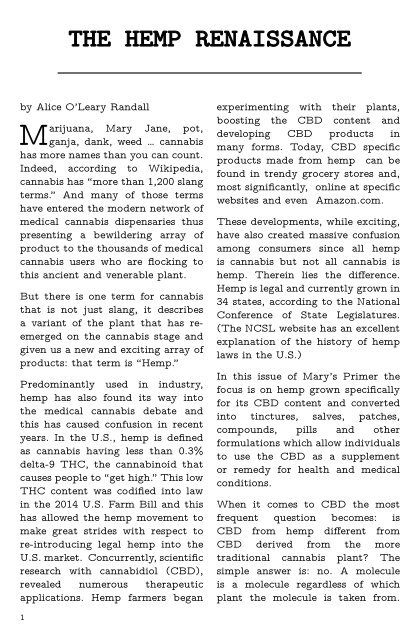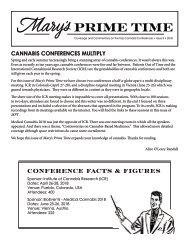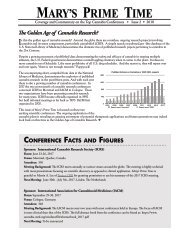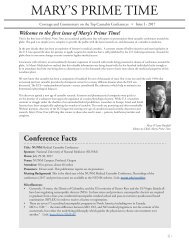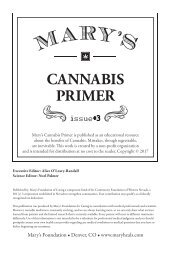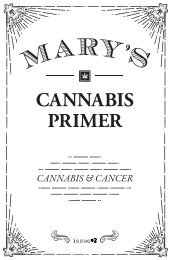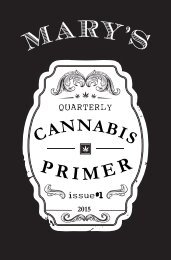#5: It's a Hemp Thing
Mary's Cannabis Primer is published as a resource for national and international education about the benefits of Cannabis. This issue is dedicated to Hemp.
Mary's Cannabis Primer is published as a resource for national and international education about the benefits of Cannabis. This issue is dedicated to Hemp.
Create successful ePaper yourself
Turn your PDF publications into a flip-book with our unique Google optimized e-Paper software.
THE HEMP RENAISSANCE<br />
by Alice O’Leary Randall<br />
Marijuana, Mary Jane, pot,<br />
ganja, dank, weed … cannabis<br />
has more names than you can count.<br />
Indeed, according to Wikipedia,<br />
cannabis has “more than 1,200 slang<br />
terms.” And many of those terms<br />
have entered the modern network of<br />
medical cannabis dispensaries thus<br />
presenting a bewildering array of<br />
product to the thousands of medical<br />
cannabis users who are flocking to<br />
this ancient and venerable plant.<br />
But there is one term for cannabis<br />
that is not just slang, it describes<br />
a variant of the plant that has reemerged<br />
on the cannabis stage and<br />
given us a new and exciting array of<br />
products: that term is “<strong>Hemp</strong>.”<br />
Predominantly used in industry,<br />
hemp has also found its way into<br />
the medical cannabis debate and<br />
this has caused confusion in recent<br />
years. In the U.S., hemp is defined<br />
as cannabis having less than 0.3%<br />
delta-9 THC, the cannabinoid that<br />
causes people to “get high.” This low<br />
THC content was codified into law<br />
in the 2014 U.S. Farm Bill and this<br />
has allowed the hemp movement to<br />
make great strides with respect to<br />
re-introducing legal hemp into the<br />
U.S. market. Concurrently, scientific<br />
research with cannabidiol (CBD),<br />
revealed numerous therapeutic<br />
applications. <strong>Hemp</strong> farmers began<br />
experimenting with their plants,<br />
boosting the CBD content and<br />
developing CBD products in<br />
many forms. Today, CBD specific<br />
products made from hemp can be<br />
found in trendy grocery stores and,<br />
most significantly, online at specific<br />
websites and even Amazon.com.<br />
These developments, while exciting,<br />
have also created massive confusion<br />
among consumers since all hemp<br />
is cannabis but not all cannabis is<br />
hemp. Therein lies the difference.<br />
<strong>Hemp</strong> is legal and currently grown in<br />
34 states, according to the National<br />
Conference of State Legislatures.<br />
(The NCSL website has an excellent<br />
explanation of the history of hemp<br />
laws in the U.S.)<br />
In this issue of Mary’s Primer the<br />
focus is on hemp grown specifically<br />
for its CBD content and converted<br />
into tinctures, salves, patches,<br />
compounds, pills and other<br />
formulations which allow individuals<br />
to use the CBD as a supplement<br />
or remedy for health and medical<br />
conditions.<br />
When it comes to CBD the most<br />
frequent question becomes: is<br />
CBD from hemp different from<br />
CBD derived from the more<br />
traditional cannabis plant? The<br />
simple answer is: no. A molecule<br />
is a molecule regardless of which<br />
plant the molecule is taken from.<br />
1


